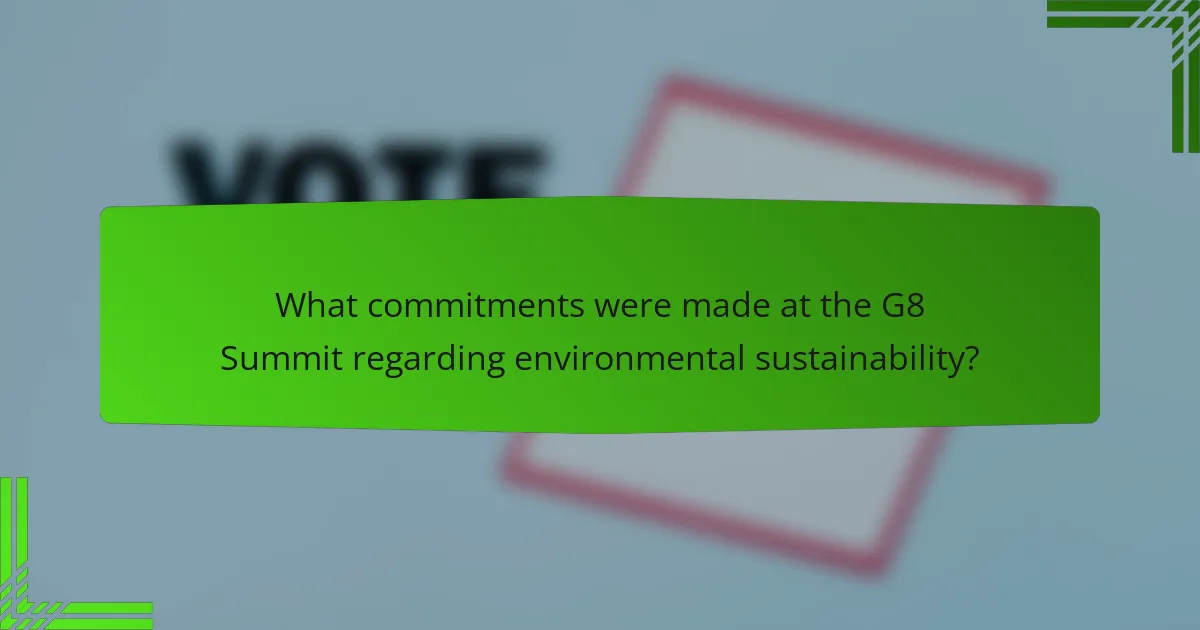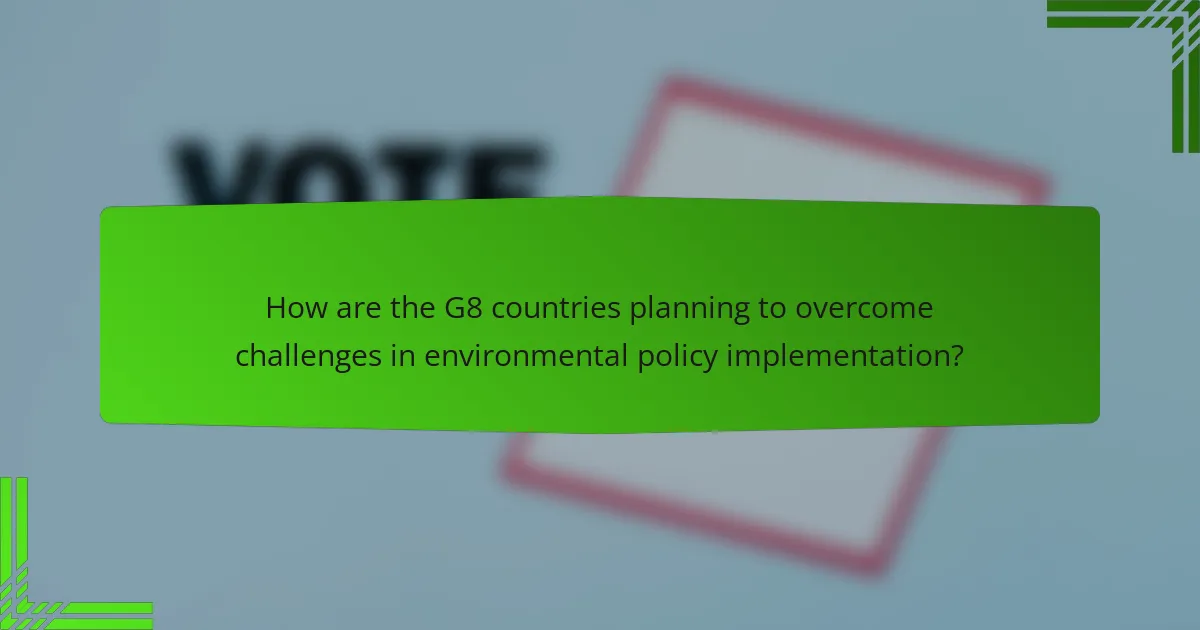The article focuses on the environmental policies discussed at the G8 Summit, highlighting key commitments and challenges faced by the participating nations. Central to these policies are climate change mitigation, sustainable development, and biodiversity conservation. G8 leaders pledged to significantly reduce greenhouse gas emissions and limit global temperature rise to below 2 degrees Celsius, while promoting renewable energy sources and enhancing energy efficiency. The summit also emphasized the importance of international cooperation and financial support for developing countries to address global environmental challenges effectively. Additionally, the article outlines strategies for implementing these policies, including establishing measurable targets and leveraging technology for sustainable practices.

What are the key environmental policies discussed at the G8 Summit?
The key environmental policies discussed at the G8 Summit include climate change mitigation, sustainable development, and biodiversity conservation. Climate change mitigation focuses on reducing greenhouse gas emissions. The G8 leaders committed to limiting global temperature rise to below 2 degrees Celsius. Sustainable development emphasizes balancing economic growth with environmental protection. The G8 addressed the need for investment in clean energy technologies. Biodiversity conservation involves protecting ecosystems and species from degradation. The summit highlighted the importance of international cooperation for environmental challenges. These policies reflect a collective commitment to addressing global environmental issues.
How do these policies address climate change?
These policies address climate change by implementing measures to reduce greenhouse gas emissions. They promote renewable energy sources and energy efficiency. The policies aim to limit global temperature rise to well below 2 degrees Celsius. They also encourage sustainable land use and forest conservation. Financial commitments support developing nations in climate adaptation. Specific targets for emission reductions are established for participating countries. Collaboration among nations enhances collective action against climate change. These actions are backed by scientific consensus on the need for urgent climate action.
What specific commitments were made by G8 leaders regarding climate action?
G8 leaders committed to reducing greenhouse gas emissions by 50% by 2050. They emphasized the importance of limiting global temperature rise to below 2 degrees Celsius. The leaders agreed to promote energy efficiency and renewable energy sources. They also pledged to support developing countries in their climate change efforts. Additionally, they recognized the need for international cooperation on climate science and technology. These commitments are aimed at fostering sustainable development and addressing climate change impacts globally.
How do these commitments compare to previous G8 summits?
The commitments made at the recent G8 summit show a stronger focus on climate change than previous summits. Unlike earlier commitments, which often lacked specific targets, this summit established measurable goals for reducing carbon emissions. For instance, it aims for a 50% reduction in emissions by 2030, a significant increase from the 40% target set in prior meetings. Additionally, the recent summit emphasized renewable energy investments, reflecting a shift from fossil fuel dependency discussed in past summits. Historical data indicates that earlier G8 summits often resulted in vague agreements without follow-through. In contrast, the current commitments include accountability measures to ensure progress. Overall, the current commitments represent a more ambitious and structured approach compared to previous G8 discussions on environmental policies.
What challenges do these environmental policies face?
Environmental policies face several significant challenges. Political resistance often hinders the implementation of these policies. Economic interests can conflict with environmental goals, leading to pushback from industries. Public awareness and understanding of environmental issues vary, affecting support for policies. Additionally, lack of funding limits the effectiveness of initiatives. International cooperation is often complicated by differing national priorities. Enforcement of regulations can be inconsistent, leading to gaps in compliance. Climate change’s complexity makes it difficult to create universally accepted solutions. Finally, short-term focus in political agendas can undermine long-term environmental strategies.
What are the main obstacles to implementing these policies?
The main obstacles to implementing environmental policies discussed at the G8 Summit include political resistance, financial constraints, and lack of public support. Political resistance often arises from differing national interests and priorities. Financial constraints limit the ability of countries to allocate necessary resources for implementation. Lack of public support can hinder policy effectiveness, as citizens may not prioritize environmental issues. Historical examples show that countries with strong political will and public engagement, such as Sweden, have successfully implemented similar policies. In contrast, nations facing significant political and financial challenges struggle to achieve their environmental commitments.
How do economic factors influence the success of these policies?
Economic factors significantly influence the success of environmental policies. The availability of funding determines the scope and reach of policy implementation. For instance, countries with robust economies can allocate larger budgets to environmental initiatives. Conversely, nations facing economic downturns may prioritize short-term growth over long-term sustainability. Economic incentives, such as subsidies for renewable energy, can encourage adoption of eco-friendly practices. Additionally, market conditions affect the feasibility of green technologies. High demand for sustainable products can drive innovation and investment. Economic stability fosters public support for environmental policies, as citizens are more willing to embrace change when their financial situation is secure. Historical data shows that successful environmental policies often correlate with strong economic performance.

What commitments were made at the G8 Summit regarding environmental sustainability?
The G8 Summit made several commitments regarding environmental sustainability. Leaders pledged to reduce greenhouse gas emissions significantly. They aimed to limit the global temperature rise to below 2 degrees Celsius. The summit emphasized the need for sustainable energy development. Commitments included increasing energy efficiency and promoting renewable energy sources. Additionally, they agreed to support forest preservation and biodiversity. The G8 also focused on enhancing international cooperation on climate change. These commitments were part of a broader strategy to address global environmental challenges.
How do these commitments aim to promote renewable energy?
These commitments aim to promote renewable energy by setting ambitious targets for reducing greenhouse gas emissions. They encourage investments in renewable technologies, such as solar and wind power. The commitments also foster international cooperation to share best practices and innovations. Additionally, they emphasize the importance of transitioning from fossil fuels to sustainable energy sources. According to the G8 Summit agreements, member countries pledged to increase the share of renewables in their energy mix. This shift is crucial for achieving energy security and combating climate change. By aligning policies with renewable energy goals, countries can stimulate economic growth and job creation in green sectors.
What specific targets were set for renewable energy adoption?
The specific targets set for renewable energy adoption include achieving 20% of global energy consumption from renewable sources by 2020. Additionally, the G8 nations committed to doubling the share of renewable energy in the global energy mix by 2030. These targets aim to significantly reduce greenhouse gas emissions and promote sustainable energy development. The commitments reflect a collective effort to transition towards a low-carbon economy.
How will these targets impact global energy consumption?
These targets will significantly decrease global energy consumption. The G8 Summit’s commitments aim to reduce carbon emissions by 50% by 2050. This reduction will lead to a shift towards renewable energy sources. Transitioning to renewables typically requires less energy overall compared to fossil fuels. Additionally, energy efficiency measures will likely be implemented to meet these targets. Improved efficiency can lower energy demand in various sectors. Historical data indicates that countries adopting similar policies have seen energy consumption decline. For instance, the European Union’s energy efficiency directive has led to a 20% reduction in energy use since its implementation.
What role do international agreements play in these commitments?
International agreements are crucial in shaping environmental commitments at the G8 Summit. They provide a framework for cooperation among nations. These agreements establish legally binding obligations and guidelines for member countries. For example, the Kyoto Protocol set specific targets for greenhouse gas emissions. International agreements also facilitate accountability through monitoring and reporting mechanisms. They encourage nations to share resources and technology for sustainable practices. Furthermore, such agreements enhance global awareness and urgency regarding environmental issues. Through collective action, countries can address challenges that transcend national borders.
Which international treaties are linked to the G8 commitments?
The international treaties linked to the G8 commitments include the Kyoto Protocol and the Paris Agreement. The Kyoto Protocol, adopted in 1997, aimed to reduce greenhouse gas emissions among developed countries. It established legally binding targets for these nations. The Paris Agreement, adopted in 2015, focuses on global efforts to limit temperature rise and enhance climate resilience. Both treaties reflect the G8’s commitment to addressing climate change and promoting sustainable development. These treaties are foundational to the international climate framework that the G8 supports.
How do these treaties enhance cooperation among G8 nations?
Treaties enhance cooperation among G8 nations by establishing common environmental goals. They facilitate coordinated efforts to address global challenges like climate change. These agreements promote sharing of best practices and technologies. They also foster financial collaboration for sustainable development projects. By setting binding targets, treaties encourage accountability among member states. The G8 nations can leverage their collective influence to drive international environmental policies. This unified approach amplifies their impact on global environmental issues. Historical examples include the Kyoto Protocol and the G8 Action Plan on Climate Change, which guided collaborative efforts.

How are the G8 countries planning to overcome challenges in environmental policy implementation?
The G8 countries plan to overcome challenges in environmental policy implementation through enhanced collaboration and shared commitments. They aim to establish clearer guidelines and frameworks for environmental policies. This includes setting measurable targets for emissions reductions. Additionally, G8 nations are focusing on leveraging technology to promote sustainable practices. Financial support for developing countries is also part of their strategy. By sharing best practices, the G8 aims to create a cohesive approach to environmental issues. Regular assessments will help track progress and adjust strategies as needed. International cooperation is emphasized to address global environmental challenges effectively.
What strategies are proposed to address resistance from various stakeholders?
Proposed strategies to address resistance from various stakeholders include engaging in dialogue, building coalitions, and providing incentives. Engaging in dialogue fosters understanding and addresses concerns directly. Building coalitions among stakeholders can unify efforts and strengthen advocacy for policies. Providing incentives, such as financial support or resources, encourages participation and compliance. These strategies are based on successful case studies from previous environmental initiatives, demonstrating their effectiveness in overcoming resistance.
How do governments plan to engage the private sector in these initiatives?
Governments plan to engage the private sector in environmental initiatives through public-private partnerships. These partnerships aim to leverage private investment for sustainable projects. Incentives such as tax breaks and grants are offered to encourage participation. Collaborative frameworks are established to align private sector goals with public environmental objectives. Governments also facilitate knowledge sharing and innovation through workshops and forums. The G8 Summit highlighted the importance of these collaborations for achieving climate targets. For instance, the commitment to reduce greenhouse gas emissions relies heavily on private sector involvement. Engaging the private sector is essential for mobilizing resources and expertise in environmental efforts.
What role does public opinion play in shaping these policies?
Public opinion significantly influences the shaping of environmental policies. Policymakers often consider public sentiment when making decisions. Strong public support for environmental issues can lead to more ambitious policy commitments. Conversely, lack of public interest may result in weaker regulations. For example, public protests and campaigns can pressure governments to adopt stricter environmental measures. Surveys indicate that citizens prioritize climate action, affecting political agendas. In recent years, movements like Fridays for Future have highlighted youth concerns, impacting discussions at forums like the G8 Summit. Thus, public opinion serves as a critical driver in the formulation and evolution of environmental policies.
What best practices can be adopted from successful environmental policies worldwide?
Best practices from successful environmental policies worldwide include implementing carbon pricing mechanisms. Countries like Sweden have effectively used carbon taxes to reduce greenhouse gas emissions by 25% since 1990. Another practice is promoting renewable energy, as seen in Germany’s Energiewende initiative. This policy has increased renewable energy’s share to over 40% of total electricity consumption. Additionally, enforcing strict regulations on pollution has proven effective, as exemplified by the United States’ Clean Air Act, which significantly reduced air pollutants. Public engagement and education are also crucial, demonstrated by Costa Rica’s environmental awareness campaigns that have fostered community involvement in conservation efforts. Lastly, international cooperation on environmental issues is vital, as shown by the Paris Agreement, which unites countries to combat climate change collectively.
Which countries have implemented effective environmental policies that G8 nations can learn from?
Germany, Sweden, and Denmark have implemented effective environmental policies that G8 nations can learn from. Germany’s Energiewende policy aims for a significant transition to renewable energy. This includes a target of 65% renewable energy in electricity consumption by 2030. Sweden is known for its carbon tax, which has successfully reduced greenhouse gas emissions since its implementation in 1991. The tax incentivizes businesses and consumers to adopt cleaner technologies. Denmark leads in wind energy production, generating over 47% of its electricity from wind turbines in 2019. These examples demonstrate successful strategies in renewable energy, carbon pricing, and sustainable practices that G8 nations can adopt.
How can G8 countries adapt these successful strategies to their unique contexts?
G8 countries can adapt successful environmental strategies by tailoring them to their specific economic, social, and environmental contexts. Each G8 nation has distinct legislative frameworks and public attitudes towards environmental issues. For instance, Canada may focus on resource management, while Germany might emphasize renewable energy technology.
Collaboration among G8 nations can facilitate the sharing of best practices. For example, Japan’s advancements in disaster resilience can inform strategies in countries vulnerable to climate-related events. Additionally, leveraging local data and stakeholder engagement will ensure that policies resonate with citizens and businesses.
Evidence from the G8 summit indicates that customized approaches yield better results. Countries that have localized strategies, such as the UK’s Climate Change Act, demonstrate effective emissions reductions. Thus, adapting strategies to fit unique contexts can enhance the effectiveness of environmental policies across G8 nations.
What are the next steps for G8 countries in advancing their environmental commitments?
G8 countries must enhance collaboration on climate change initiatives. They should implement and strengthen existing agreements like the Paris Agreement. Increasing financial support for green technologies is essential. They need to establish specific targets for reducing greenhouse gas emissions. Promoting renewable energy sources will be crucial for sustainable development. G8 countries should also prioritize biodiversity conservation efforts. Engaging with non-governmental organizations can help in monitoring progress. Regular assessments and reports on environmental commitments will ensure accountability.
How will progress be monitored and reported by G8 nations?
Progress by G8 nations will be monitored and reported through established frameworks and regular assessments. Each nation will submit periodic reports detailing their commitments to environmental policies. These reports will include data on emissions reductions, renewable energy adoption, and resource management. Independent assessments will evaluate the accuracy and effectiveness of these reports. The G8 will utilize international benchmarks for comparison. Collaborative platforms will facilitate information sharing among member nations. Public transparency will be emphasized to enhance accountability. These measures aim to ensure that commitments made at the G8 Summit are met effectively.
What actions can individuals take to support these commitments?
Individuals can support environmental commitments by adopting sustainable practices in their daily lives. They can reduce energy consumption by using energy-efficient appliances. Using public transportation or carpooling can minimize carbon footprints. Individuals should also recycle and properly dispose of waste to reduce landfill impact. Supporting local and sustainable products promotes environmentally friendly practices. Participating in community clean-up events helps restore natural habitats. Advocating for policy changes through petitions or contacting representatives raises awareness. Educating others about environmental issues fosters a collective commitment to sustainability.
The main entity of the article is the environmental policies discussed at the G8 Summit, which encompass climate change mitigation, sustainable development, and biodiversity conservation. The article outlines the commitments made by G8 leaders to reduce greenhouse gas emissions, promote renewable energy, and support developing nations in climate adaptation efforts. It also addresses the challenges these policies face, including political resistance and financial constraints, while highlighting the role of international agreements in enhancing cooperation among member countries. Additionally, the article explores best practices from successful environmental policies worldwide that G8 nations can adopt to advance their commitments effectively.